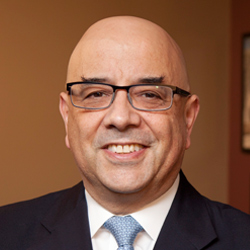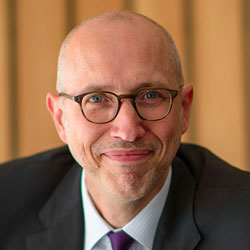PhD Seminar Series Explores Relationship Between Art and Science
More than 70 students attended the lecture delivered by Deans Julio M. Ottino and Adrian Randolph
More than 70 PhD students attended a lunchtime lecture at the Ford Motor Company Engineering Design Center on October 8 to hear the presentation, “When Art, Technology, and Science Were One: Why They Split and How They Could Join Again.”
Julio M. Ottino, dean of the Robert R. McCormick School of Engineering and Applied Science, and Adrian Randolph, dean of the Judd A. and Marjorie Weinberg College of Arts and Sciences, presented to a full crowd about the relationship between art and science as the first lecture of the 2018-19 Whole-Brain Leadership for PhD Students Seminar Series.
“We are trying to present a way to think through: ‘are there ways in which we can use the Renaissance as an example of interdisciplinary boundary-crossing within the organizations we’ve inherited?’” said Randolph, a professor of art history.

In the 18th century Wilhelm von Humboldt founded the Humboldt University of Berlin, which became the model of the modern university. Somewhat paradoxically, rather than leading to unification of knowledge, universities became a collection of different, sometimes non-interacting disciplines. Under this model, knowledge became more siloed by field, and art and science became separate fields at the university level. At Northwestern, Ottino and Randolph are collaborating on a number of projects to bring the arts and sciences together again.
“When I was a graduate student, I longed to have situations that would have broadened my horizons,” Ottino said. “This idea of whole-brain thinking, augmenting analytical, rational, and quantitative thinking with divergent creative thinking is what is needed today. It gives people a much broader thinking setting to solve problems when you have the reason and tools to solve them."
 In the early Renaissance in 15th century Italy, art and science were frequently interwoven. Leonardo da Vinci and Michelangelo, for instance, each conducted dissections of cadavers to try to understand the body’s inner workings, which they portrayed in art depicting human anatomy, Randolph explained.
In the early Renaissance in 15th century Italy, art and science were frequently interwoven. Leonardo da Vinci and Michelangelo, for instance, each conducted dissections of cadavers to try to understand the body’s inner workings, which they portrayed in art depicting human anatomy, Randolph explained.
Another Renaissance artist, who designed the iconic dome on Florence’s Cathedral, could be regarded as one of the first modern engineers, “Filippo Brunelleschi’s interdisciplinary thinking, being a sculptor, a goldsmith, a designer, doing theatrical work, gave him mental tools that his compatriots didn’t have,” Randolph said of the Italian designer, mathematician, and ship designer.
In the 16th century, Galileo Galilei and Thomas Harriot offered a stark contrast about the augmentation of thinking due to art, which lead Galileo to calculate the height of the moon’s craters, said Ottino, Distinguished Robert R. McCormick Institute Professor and Walter P. Murphy Professor of Chemical and Biological Engineering and (by courtesy) Mechanical Engineering.
In the 1800s, Louis Pasteur benefited by bring an art component to his scientific work. “Pasteur is known for many things like fermentation, preventing illnesses of different kinds, and he was a noted chemist. When he was young, he also was an artist,” said Ottino, himself an artist. Pasteur’s artistic background is credited with helping him discover chirality, molecules that exist in mirror-image forms.
“It is not that art directly influences science and technology,” Ottino concluded, “It is that art leads to an augmentation of thinking that can influence science and technology.”